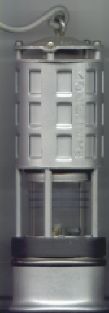Blackdamp
Blackdamp is a mining term for a particular mine atmosphere or gaseous mixture found in underground coal mines, which is characterized by the presence of high levels of carbon dioxide (CO2) and low levels of oxygen (O2). Blackdamp is also known by its technical name, "choke damp". The term "damp" is used in the mining industry to refer to various harmful gases found in mines, and the prefix "black" refers to the suffocating effect of this particular gas mixture, which can lead to unconsciousness or death due to asphyxiation.
Composition and Formation[edit | edit source]
Blackdamp is primarily composed of carbon dioxide, a heavy, colorless, odorless gas that is produced through the oxidation of coal and the respiration of humans and animals. The oxygen levels in an area affected by blackdamp can be significantly reduced, as oxygen is consumed by the oxidation processes and by breathing organisms, and is displaced by the increasing concentration of carbon dioxide. This creates an environment that is not supportive of human life or the combustion of fires, which can extinguish lamps and other sources of open flames used by miners for illumination.
Hazards[edit | edit source]
The primary hazard associated with blackdamp is asphyxiation. Humans require a certain level of oxygen in the air to breathe and function; typically, air is composed of about 21% oxygen. In environments where the oxygen level falls below 19.5%, the air is considered to be oxygen-deficient, and prolonged exposure can lead to unconsciousness and death. Blackdamp environments can have much lower levels of oxygen, making them immediately dangerous to life and health (IDLH).
Detection of blackdamp in historical times was challenging due to the lack of advanced detection equipment. Miners would sometimes use canaries or other small animals as indicators of bad air; if the animal became distressed or died, it was a sign that the air quality was poor and potentially lethal.
Prevention and Control[edit | edit source]
The prevention and control of blackdamp involve adequate ventilation to ensure a continuous supply of fresh air and the removal of harmful gases. Modern mining operations use sophisticated ventilation systems designed to manage the atmospheric conditions within the mine. These systems not only supply fresh air but also monitor gas levels to prevent the accumulation of dangerous gases such as blackdamp.
In addition to mechanical ventilation, practices such as sealing off abandoned sections of the mine and monitoring the atmosphere within the mine are crucial for maintaining safety. Miners are also equipped with personal safety equipment, including self-rescuer devices that provide breathable air in case of exposure to harmful gases.
See Also[edit | edit source]
This safety related article is a stub. You can help WikiMD by expanding it.
Search WikiMD
Ad.Tired of being Overweight? Try W8MD's physician weight loss program.
Semaglutide (Ozempic / Wegovy and Tirzepatide (Mounjaro / Zepbound) available.
Advertise on WikiMD
|
WikiMD's Wellness Encyclopedia |
| Let Food Be Thy Medicine Medicine Thy Food - Hippocrates |
Translate this page: - East Asian
中文,
日本,
한국어,
South Asian
हिन्दी,
தமிழ்,
తెలుగు,
Urdu,
ಕನ್ನಡ,
Southeast Asian
Indonesian,
Vietnamese,
Thai,
မြန်မာဘာသာ,
বাংলা
European
español,
Deutsch,
français,
Greek,
português do Brasil,
polski,
română,
русский,
Nederlands,
norsk,
svenska,
suomi,
Italian
Middle Eastern & African
عربى,
Turkish,
Persian,
Hebrew,
Afrikaans,
isiZulu,
Kiswahili,
Other
Bulgarian,
Hungarian,
Czech,
Swedish,
മലയാളം,
मराठी,
ਪੰਜਾਬੀ,
ગુજરાતી,
Portuguese,
Ukrainian
Medical Disclaimer: WikiMD is not a substitute for professional medical advice. The information on WikiMD is provided as an information resource only, may be incorrect, outdated or misleading, and is not to be used or relied on for any diagnostic or treatment purposes. Please consult your health care provider before making any healthcare decisions or for guidance about a specific medical condition. WikiMD expressly disclaims responsibility, and shall have no liability, for any damages, loss, injury, or liability whatsoever suffered as a result of your reliance on the information contained in this site. By visiting this site you agree to the foregoing terms and conditions, which may from time to time be changed or supplemented by WikiMD. If you do not agree to the foregoing terms and conditions, you should not enter or use this site. See full disclaimer.
Credits:Most images are courtesy of Wikimedia commons, and templates, categories Wikipedia, licensed under CC BY SA or similar.
Contributors: Prab R. Tumpati, MD

